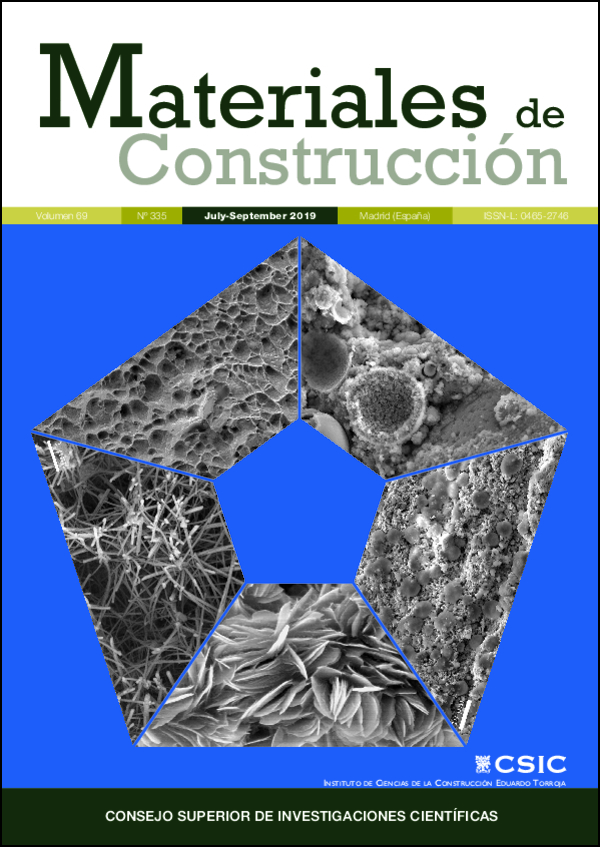Modelo de cálculo del rendimiento a compresión y capacidad de carga de columnas con pequeñas excentricidades reforzadas con mortero reforzado con textiles (TRM)
DOI:
https://doi.org/10.3989/mc.2019.08418Palabras clave:
Composite, Refuerzo de fibras, Propiedades mecánicas, ModelizaciónResumen
En este trabajo se estudió el rendimiento a compresión de columnas reforzadas con TRM con pequeñas excentricidades, y para ello, se sometieron a pruebas de compresión a nueve columnas de hormigón armado (RC) con ménsulas finales. Los parámetros estudiados fueron: el número de capas textiles, la relación de refuerzo longitudinal y la fracción en volumen de fibras cortas de alcohol polivinílico (PVA). Los resultados experimentales indicaron que, en comparación con el control, las columnas con tres capas de textiles mostraron un aumento de aproximadamente el 10,66% en la capacidad de carga. Sin embargo, el aumento fue ligero cuando el número de capas textiles aumentó a cuatro. Además, el efecto mejoró con el aumento en la proporción de refuerzo longitudinal y la fracción en volumen de fibras de PVA. Finalmente, basándonos en las pruebas de laboratorio y resultados de investigación previos, se presentó un modelo para calcular la capacidad de carga de la sección normal de columnas reforzadas con TRM con pequeñas excentricidades. Una comparación de los datos teóricos y experimentales demostró la aplicabilidad del modelo propuesto.
Descargas
Citas
Bournas, D.A.; Pavese, A.; Tizani, W. (2015) Tensile capacity of FRP anchors in connecting FRP and TRM sheets to concrete. Eng. Struct. 82, 72-81. https://doi.org/10.1016/j.engstruct.2014.10.031
Bisby, L.; Ranger, M. (2010) Axial-flexural interaction in circular FRP-confined reinforced concrete columns. Constr. Build. Mater. 24 [9], 1672-1681. https://doi.org/10.1016/j.conbuildmat.2010.02.024
Ombres, L.; Verre, S. (2015) Structural behaviour of fabric reinforced cementitious matrix (FRCM) strengthened concrete columns under eccentric loading. Compos. Pt. B-Eng. 75, 235-249. https://doi.org/10.1016/j.compositesb.2015.01.042
Xu, S.L.; Li, H. (2007) Bond Properties and Experimental Methods of Textile Reinforced Concrete. J. Wuhan Univ. Technol.-Mat. Sci. Edit. 22 [3], 529-532. https://doi.org/10.1007/s11595-006-3529-9
Mechtcherine, V. (2013) Novel cement-based composites for the strengthening and repair of concrete structures. Constr. Build. Mater. 41, 365-373. https://doi.org/10.1016/j.conbuildmat.2012.11.117
Papanicolaou, C.G.; Triantafillou, T.C.; Karlos, K.; Papathanasiou, M. (2007) Textile-reinforced mortar (TRM) versus FRP as strengthening material of URM walls: In-plane cyclic loading. Mater. Struct. 40 [10], 1081-1097. https://doi.org/10.1617/s11527-006-9207-8
Trapko, T. (2014) Behaviour of fibre reinforced cementitious matrix strengthened concrete columns under eccentric compression loading. Mater. Des. 54 [2], 947-954. https://doi.org/10.1016/j.matdes.2013.09.008
Sheng, J.; Yin, S.P.; Wang, F. (2017) Experimental study on the fatigue behaviour of RC beams strengthened with TRC after sustained load corrosion. Constr. Build. Mater. 131, 713-720. https://doi.org/10.1016/j.conbuildmat.2016.11.030
Elsanadedy, H.M.; Almusallam, T.H.; Alsayed, S.H.; Alsalloum, Y.A. (2013) Flexural strengthening of RC beams using textile reinforced mortar-Experimental and numerical study. Compos. Struct. 97 [2], 40-55. https://doi.org/10.1016/j.compstruct.2012.09.053
Larbi, A.S.; Agbossou, A.; Hamelin, P. (2013) Experimental and numerical investigations about textile-reinforced concrete and hybrid solutions for repairing and/or strengthening reinforced concrete beams. Compos. Struct. 99, 152-162. https://doi.org/10.1016/j.compstruct.2012.12.005
Schladitz, F.; Frenzel, M.; Ehlig, D.; Curbach, M. (2012) Bending load capacity of reinforced concrete slabs strengthened with textile reinforced concrete. Eng. Struct. 40, 317-326. https://doi.org/10.1016/j.engstruct.2012.02.029
Triantafillou, T.C.; Papanicolaou, C.G.; Zissimopoulos, P.; Laourdekis, T. (2006) Concrete confinement with textilereinforced mortar jackets. ACI Struct. J. 103 [1], 28-37. https://doi.org/10.14359/15083
Bournas, D.A.; Lontou, P.V.; Papanicolaou, C.G.; Triantafillou, T.C. (2007) Textile-reinforced mortar versus fiber-reinforced polymer confinement in reinforced concrete columns. ACI Struct. J. 104 [6], 740-748. https://doi.org/10.14359/18956
Trapko, T. (2013) Stress-strain model for FRCM confined concrete elements. Compos. Pt. B-Eng. 45 [1], 1351-1359. https://doi.org/10.1016/j.compositesb.2012.07.001
Yin, S.P.; Xu, S.L.; Wang, F. (2015) Investigation on the flexural behavior of concrete members reinforced with epoxy resin-impregnated textiles. Mater. Struct. 48 [1-2], 153-166. https://doi.org/10.1617/s11527-013-0174-6
Yin, S.P.; Peng, C.; Jin, Z.Y. (2017) Research on mechanical properties of axial-compressive concrete columns strengthened with TRC under a conventional and chloride wet-dry cycle environment. J. Compos. Constr. 21 [1], 04016061. https://doi.org/10.1061/(ASCE)CC.1943-5614.0000725
Xu, S.L.; Li, Q.H.; Li, H.D. (2008) An experimental study on the flexural properties of carbon textile reinforced ECC. Chin. Civil. Eng. J. 40 [12], 69-76.
American Concrete Institute. (2013) Guide to design and construction of externally bonded fabric Reinforced Cementitious Matrix (FRCM) systems for repair and strengthening concrete and masonry structures. ACI 549.4R-13, ACI Committee 549. Farmington Hills, MI.
Trapko, T. (2014) Confined concrete elements with PBOFRCM composites. Constr. Build. Mater. 73, 332-338. https://doi.org/10.1016/j.conbuildmat.2014.09.055
Teng, J.G.; Huang, Y.L.; Lam, L.; Ye, L.P. (2007) Theoretical Model for Fiber-Reinforced Polymer-Confined Concrete. J. Compos. Constr. 11 [2], 201-210. https://doi.org/10.1061/(ASCE)1090-0268(2007)11:2(201)
Pan, Y.; Cao, S.Y.; Jing, D.H.; Chen, D.B. (2009) Test and analysis of the axial stress-strain relationship of square section concrete columns confined by CFRP under preload. Chin. Civil. Eng. J. 42 [1], 23-29.
Pan, Y.; Guo, R.; Li, H.G.; Tang, H.Y.; Huang, J.X. (2017) Analysis-oriented stress-strain model for FRP-confined concrete with preload. Compos. Struct. 166 [3], 57-67. https://doi.org/10.1016/j.compstruct.2017.01.007
Yin S.P.; Xu, S.L.; Lv H.L. (2014) Flexural Behavior of Reinforced Concrete Beams with TRC Tension Zone Cover. J. Mater. Civ. Eng. 26 [2], 320-330. https://doi.org/10.1061/(ASCE)MT.1943-5533.0000811
Trapko, T. (2014) Effect of eccentric compression loading on the strains of FRCM confined concrete columns. Constr. Build. Mater. 61, 97-105. https://doi.org/10.1016/j.conbuildmat.2014.03.007
Publicado
Cómo citar
Número
Sección
Licencia
Derechos de autor 2019 Consejo Superior de Investigaciones Científicas (CSIC)

Esta obra está bajo una licencia internacional Creative Commons Atribución 4.0.
© CSIC. Los originales publicados en las ediciones impresa y electrónica de esta Revista son propiedad del Consejo Superior de Investigaciones Científicas, siendo necesario citar la procedencia en cualquier reproducción parcial o total.
Salvo indicación contraria, todos los contenidos de la edición electrónica se distribuyen bajo una licencia de uso y distribución “Creative Commons Reconocimiento 4.0 Internacional ” (CC BY 4.0). Consulte la versión informativa y el texto legal de la licencia. Esta circunstancia ha de hacerse constar expresamente de esta forma cuando sea necesario.
No se autoriza el depósito en repositorios, páginas web personales o similares de cualquier otra versión distinta a la publicada por el editor.
















